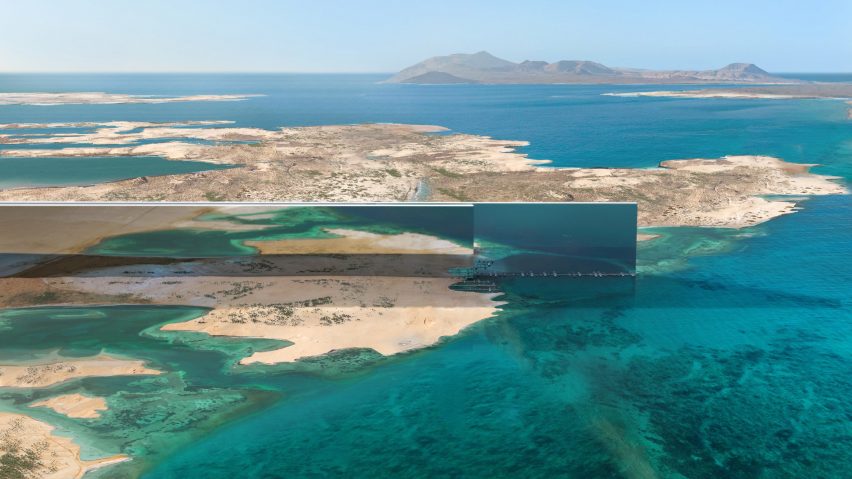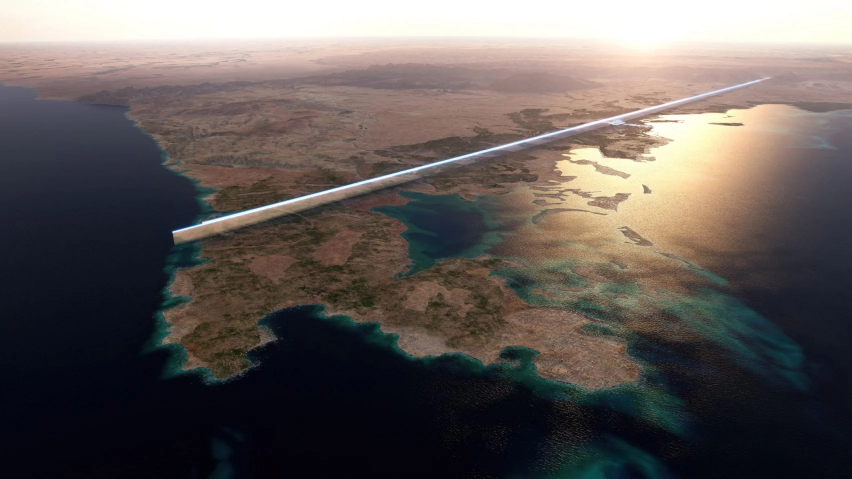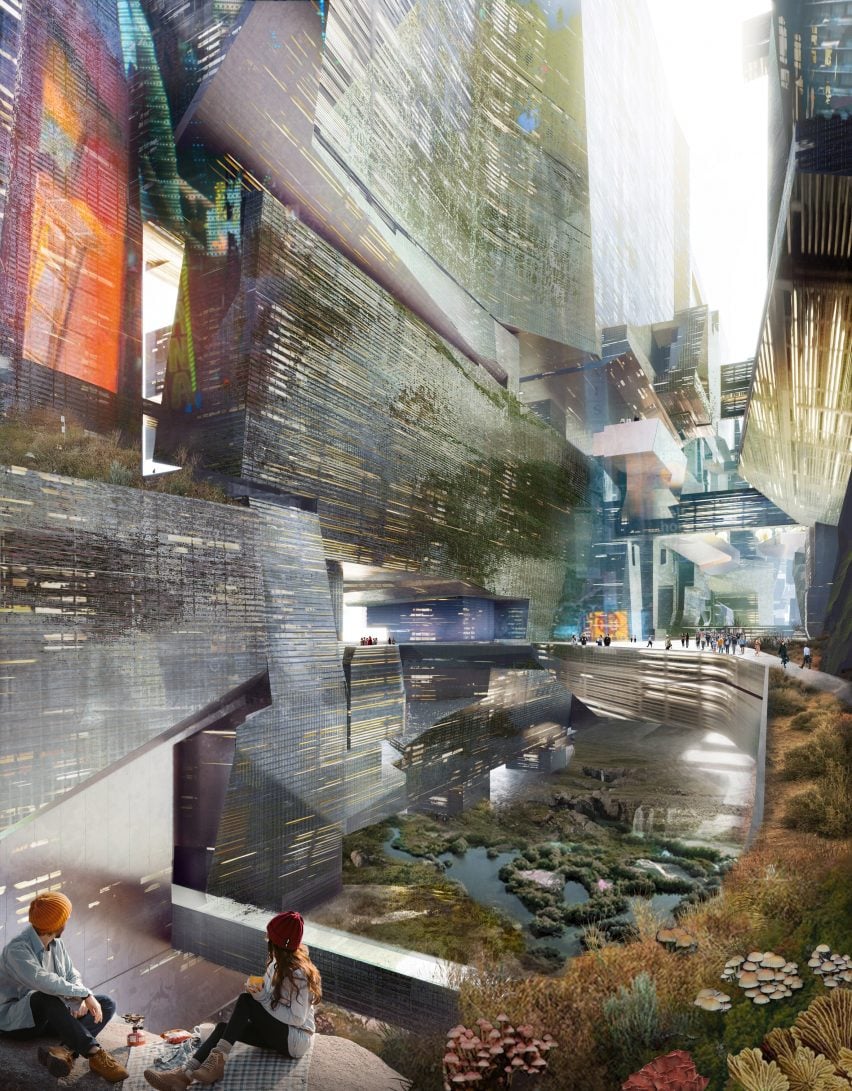The Line architects explain Saudi mega city in Discovery Channel documentary
Architects including Thom Mayne, Peter Cook and Reinier de Graaf have explained the thinking behind planned megacity The Line in a recently released 45-minute documentary.
Numerous architects feature in the recent Discovery Channel documentary, which is named The Line: Saudi Arabia's City of the Future in Neom, alongside members of the Neom team and Saudi Arabia's crown prince Mohammed bin Salman.
"I can't think of anybody that wouldn't want to be part of this project," said Morphosis founder Mayne, while Cook Haffner Architecture Platform co-founder Cook said that "if it succeeds, it will be a new Babylon".
The 45-minute-long documentary marks the first time the majority of architects connected to the 170-kilometre-long city, which has largely been developed in secret, have spoken at length about it in public.

Mayne explained how Morphosis had developed the concept for The Line, which forms part of the Neom mega project, as its entry to an invited competition to design a new city.
"It's actually a complicated project, but the big idea is incredibly simple," he explained.
In the documentary, Cook Haffner Architecture Platform is described as the project's lead designer. Cook explained how the project builds on his ideas for the Plugin City developed in the 1960s with Archigram.
He described his ambition for the city and was critical of current architectural thinking describing young architects as "scared".
"There is a certain moral atmosphere – we shouldn't be too clever," he said. "You shouldn't need to experiment, don't do anything too funky – I came out of a funky period."
"It's always assumed the young are more progressive," he continued. "Now, I think the youngest architects are nervous. They're very nervous. They're not natural experimenters. They're a bit scared."

According to the documentary, the current plans will see the city, which is currently under construction, divided into 140 modules. Each module will be 800 metres long and house 80,000 people.
Each of the first five of these modules will be developed by a different architecture studio picked "from a playing field of 20". Each studio will "develop their own module and bring The Line into reality".
The film features interviews with architects from six studios – Morphosis, Cook Haffner Architecture Platform, Pei Cobb Freed & Partners, HOK, LAVA and OMA. However, OMA previously confirmed to Dezeen it was not currently working on the project.
"We participated in the competition in 2021," a spokesperson reconfirmed to Dezeen. "We are currently not working on the project."
HOK clarified that the studio was also not currently working on the project. "HOK was engaged in an early stage of design on The Line but is no longer participating in the project," said a spokesperson.

The other architects in the documentary aimed to explain the uniqueness of the project and how they believe it could offer an alternative to current cities.
"We as architects and urbanists have to think differently about everything," said Michael Bischoff, partner at Pei Cobb Freed & Partners.
"The questions and the threat on our planet is so immense, that I really don't understand that we try to answer these questions with old answers," said LAVA co-founder Alexander Rieck.
"There's an enormous responsibility that comes with that because you're dealing with the lives of people that are going to live here," added HOK design principal Roger Soto.
The documentary was also the first time the Saudi crown prince Mohammed bin Salman, who is leading the development of The Line, spoke at length about the project. In the film, he dismissed people's scepticism of the project.
"They say a lot of projects in Saudi Arabia can't be done, they're too ambitious," Mohammed bin Salman said in the documentary. "They can keep saying that and we can keep proving them wrong."
The Line is one of the world's largest and most controversial projects, although this is not mentioned in the documentary. It has been criticised on sustainability and liveability grounds as well as its human rights record.
Last year human rights organisation ALQST reported that three people who were evicted from the Neom site have been sentenced to death. Early this year, UN Human Rights Council experts expressed "alarm" over the imminent executions.
Speaking to Dezeen, Amnesty International's Peter Frankental said that companies working on Neom were facing a "moral dilemma" and should "think twice" about their continuing involvement in the project.
What the architects said about The Line:
Peter Cook, founder, Cook Haffner Architecture Platform
"There is a certain moral atmosphere – we shouldn't be too clever. You shouldn't need to experiment. Don't do anything too funky, I came out of a funky period."
"If it succeeds, it will be a new Babylon, so to speak. And if it doesn't succeed, it will be an interesting phenomenon."
"The Line is something that is intriguing to many people, puzzling to many people, and in some ways, puzzling even to those who are involved in designing it."
"It's always assumed the young are more progressive. Now, I think the youngest architects are nervous. They're very nervous. They're not natural experimenters. They're a bit scared."
"I think the best cities are slightly naughty."
Thom Mayne, founding partner, Morphosis
"I can't think of anybody that wouldn't want to be part of this project, it's going to be, without a question, the single most extraordinary piece of work that begins in the first quarter of the 21st century."
"It's actually a complicated project, but the big idea is incredibly simple."
"In our presentation, we showed a conceptual map that took New York apart. It was very important to us to develop the scale that broke down socially into communities that had personalities and gave people opportunities to live in very different environments like you would in London or Manhattan."
"I drive a Tesla, and I see that now that's transitional. That's the last car before there's no cars."
Branko Belaćević, partner, Cook Haffner Architecture Platform
"There was a moment in the development of the project when people started saying, 'I could live there'. People are starting to believe that it's possible"
Eui-Sung Yi, partner, Morphosis
"It's almost inevitable that a project like Neom should be engaged."
"You can imagine the amount of naysayers, you could imagine the amount of critics and those who are kind of worried if it was even possible."
"What if we just say that the ground is now multiple grounds, rather than always a singular ground that we always go down to."
"The ambition is proportional to the challenges."
Erlend Blasted Haffner, founder, Cook Haffner Architecture Platform
"What it will lead to will be interesting for all architects. It will have an impact on our profession, I think."
Roger Soto, design principal, HOK
"As soon as you start to get into it, you start to sort of think about the possibilities of it. And your mind starts to sort of begin to imagine that, yeah, it is maybe possible."
"We as architects and urbanists have to think differently about everything."
"Vertical transportation is a little bit more like a subway system. You're not like calling an elevator, it's just arriving on a regular basis. And you're moving up and down."
"There's an enormous responsibility that comes with that because you're dealing with the lives of people that are going to live here. And that's going to have families here."
Alexander Rieck, co-founder, LAVA
"The questions and the threat on our planet is so immense, that I really don't understand why we try to answer these questions with old answers."
"It has not been done before. We need this pioneering spirit in order to create, not only cities, but to create a planet, which will sustain the next couple of 1,000 years.
"Neom itself is one of the most amazing places in the past decade where the best minds are coming together. And we can test out different solutions."
Wael Sleiman, architect, OMA
"Humans in general, they tend to go horizontal and avoid vertical by all means possible. Lifts and stairs and things like that are abrupt interruption during movement. They hate it."
Michael Bischoff, partner, Pei Cobb Freed & Partners
"You look around at cultures that are just propagating endless fields of point towers, and saying that that's the way to create a society, then you ask yourself, maybe we should rethink this, maybe we should have some new urban ideas"
"It is inspiring to take things that we've seen happening in sci-fi and say, is it really sci-fi? Or is it really the world, that's what is at the heart of this."
"We've realised that if you're 500 metres tall, that there was a spot at about 300 metres high that we felt was a sweet spot urbanistically and allowed for a place that people could come together and provide the livable public realm."
"You can't do this if you're not excited about it."
Reinier de Graaf, partner, OMA
"My immediate reaction was, what the hell is this?"
"A state of panic, that should almost emerge if you really take it seriously, that's curiously absent from a lot of projects. And I do believe that in the context of this operation, the state of panic, for whatever reason, is abundantly present."
"It is very easy to imagine that it will go wrong. Maybe this is essential to imagine it going right. And of course, architects are by definition, optimists."
Iyad Alaska, partner, OMA
"When you work on a project that deep it becomes part of your working hours every day and you're dreaming hours also. You always want to live in your projects. I mean, it's something we struggle with all the time."